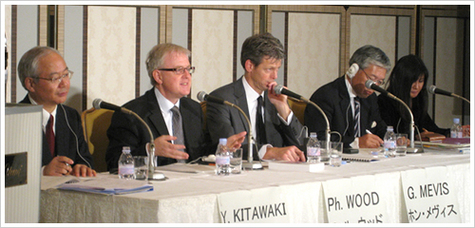Activity Reports:Japanese Studies and Intellectual Exchange:Programme Report "Intercultural City and Multicultural Symbiosis" Organized by the Japan Foundation and the Council of Europe
Tomoaki Shimane
Europe, Middle East and Africa Section
Japanese Studies and Intellectual Exchange Dept.
From October 31 to November 7, 2009, the Japan Foundation and the Council of Europe invited to Japan a group consisted of the representatives of Tilburg / the Netherlands, Neuchâtel / Switzerland, Patras / Greece, among the member cities of "Intercultural cities" programme; Mr. Phil Wood, a co-coiner of the term "Intercultural city"; and other experts. They made a study visit to Kani city and Minokami city of Gifu prefecture and Kobe city of Hyogo prefecture to see practical examples of "multicultural symbiosis" in Japan, prior to participate in an open symposium in Tokyo.
>> Click here for Programme Report in Japanese (PDF) (4.35MB)
>> Click here for Programme Report in English (PDF) (4.35MB)
Outline
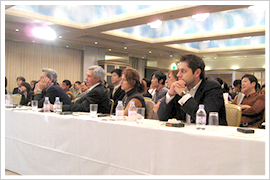 The Intercultural City does not view diversity as a threat, nor simply "cope" with it, but utilizes it as a source of dynamism, innovation, creativity and growth. Based on this latest idea, the Council of Europe has started the "Intercultural cities" programme with 12 cities in Europe to exchange expertise and experience among each other.
The Intercultural City does not view diversity as a threat, nor simply "cope" with it, but utilizes it as a source of dynamism, innovation, creativity and growth. Based on this latest idea, the Council of Europe has started the "Intercultural cities" programme with 12 cities in Europe to exchange expertise and experience among each other.
In Japan, in order to facilitate peaceful co-existence between indigenous and foreign inhabitants in a community, various policies are being carried out with the idea of "multicultural symbiosis" (Tabunka-kyosei). Some of these policies present strong parallel cases with those in the intercultural cities, where diversity is regarded as strength and participation in community activities are encouraged all across the ethnic landscape.
However, these initiatives towards integration at regional and community levels in Europe and Japan have not been fully introduced to each other, let alone studied comparatively.
This invitation programme and following symposium aimed at building bridges between Japan and Europe in order to share broader perspectives and exchange different points of view to mark the first step toward future exchanges.
List of participants
Members of the delegation from member cities of the "Intercultural cities" programme in Europe
Tilburg, the Netherlands
Mr Gon MEVIS, Vice mayor, Tilburg Municipality
Neuchâtel, Switzerland
Mr Thomas FACCHINETTI, Member of Neuchâtel's Parliament, Head of the Multicultural Cohesion Office of the Canton on Neuchâtel
Patras, Greece
Mr Panos KITROU, Councillor, President of Patras Municipal Enterprise for Planning & Development - ADEP S.A., El.Venizelou
Council of Europe
Ms Gabriella BATTAINI-DRAGONI, Director General for Education, Culture and Heritage, Youth and Sport and Co-ordinator for Intercultural dialogue
Ms Irena GUIDIKOVA, Project Manager Intercultural cities
Experts
Mr Phil WOOD, Philip Wood Associates Ltd, United Kingdom
Mr Olexandr BUTSENKO, Director, Development Centre "Democracy through Culture", Ukraine
Prof. Pierre SALAMA, Université Paris 13-Centre d'Economie de Paris nord, France
Mr Thijs MALMBERG, Manager, Ordina Public Management Consulting, the Netherlands
Study Tour in Japan (November 1-5, 2009)
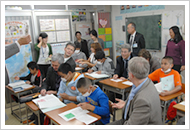 Kani City (Gifu Prefecture)
Kani City (Gifu Prefecture)
・the Kani City Multicultural Festival
・the Kani City Multicultural Center "Frevia"
・the Kani City Hall
・Kani City Bara Kyoshitsu Kani or the Rose Classroom, an international classroom similar to a preparatory school for children of foreign residents
・the Kani Public Arts Center "ala"
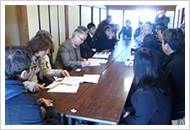 Minokamo City (Gifu Prefecture)
Minokamo City (Gifu Prefecture)
・the Community Hall of Minokamo City
・Nakasendo Hall
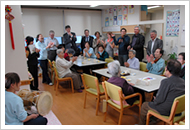 Kobe City (Hyogo Prefecture)
Kobe City (Hyogo Prefecture)
・the Kobe City Hall
・the Kobe Foreigners Friendship Center
・the Takatori Community Center
・the Kobe Center for Overseas Migration and Cultural Interaction;
Symposium (November 6, 2009)
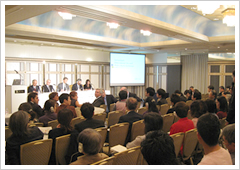 At the introduction, Ms Gabriella BATTAINI-DRAGONI from the Council of Europe explained the organization and a white paper on intercultural dialog entitled "Living Together as Equals in Dignity" that was adopted by the Council of Europe.
At the introduction, Ms Gabriella BATTAINI-DRAGONI from the Council of Europe explained the organization and a white paper on intercultural dialog entitled "Living Together as Equals in Dignity" that was adopted by the Council of Europe.
Her presentation was followed by Mr. Phil Wood who described the concept of "Intercultural Cities." He stated that in the intercultural city people were encouraged to retain and celebrate their diverse cultures, and the dynamism and the energy of the intercultural city come from different entities jostling together in a constant hybridization. He also described a tool kit to formulate an intercultural city policy to put the concepts into practice.
At the beginning of the symposium moderated by Prof. Yasuyuki Kitawaki (Director of Centre for Multilingual Multicultural Education and Research, Tokyo University of Foreign Studies), Mr. Gon Mevis shared his understanding and feelings about the visits. He pointed out that as the number of migrants in Japan increased, European experiences could be used to avoid problems generated from the larger population with foreign nationalities. As an overview of what they saw during the visit, he listed good examples, some less example that had room for improvement and some advices.
Mr. Wood commented on the visit that multicultural symbiosis and intercultural cities had the dynamics in common, but Japan should give fundamental guarantees for everyone in the society if the country wanted people to really contribute to Japanese society.
In response to their comments, Mr. Yoshimi Sakai (the former Director of Multicultural Symbiosis Section of Minokamo city) introduced the Council for Cities of Non-Japanese Residents and mentioned that sustainability of a community could be enhanced by building a strong face-to-face relationship between Japanese and foreign citizens. Ms. Shizuyo YOSHITOMI, Vice President of Takatori Community Center, Kobe, commented that community businesses were the key factor to carry out various programs with foreign citizens.
Prof. Kitawaki, the moderator, picked up three key points from speeches. The first point was plan and implement strategies to consider immigrants or foreign citizens as an advantage or an opportunity; The second was that not only immigrants or foreign citizens should change, but also the entire society or people of the host society should change so that everyone could participate in building up a society of multicultural symbiosis or an intercultural city; The third point was protection of human rights. The discussion with the audience focused on these three points.
We received feedback from the audience: some responded favorably by stating that it was very interesting and meaningful occasion to know the current situation in Europe, while others remarked that there were so many issues to discuss but the time allowed for discussion was too short. These comments revealed that this was the issue of sincere concern for people and it required further discussions between Japan and Europe.
Related Articles
Back Issues
- 2025.9.30 The 51st Japan Found…
- 2025.9.30 The Japan Foundation…
- 2025.9.30 Bringing the World C…
- 2025.9.30 The 51st (2024) Japa…
- 2025.9.30 Japan Foundation Pri…
- 2024.5.24 The 50th Japan Found…
- 2024.3. 4 Movie Theaters aroun…
- 2023.4.10 The 49th Japan Found…
- 2023.3.28 JF's Initiatives for…
- 2023.1.27 Living Together with…


